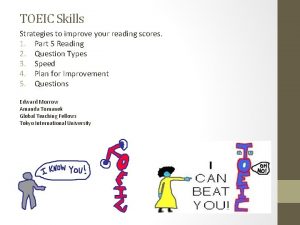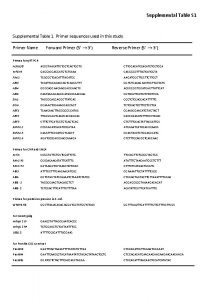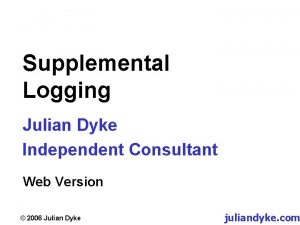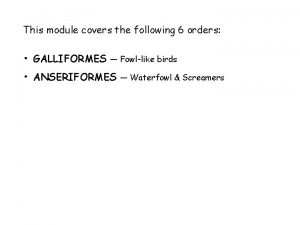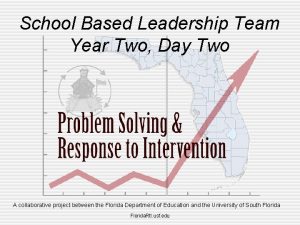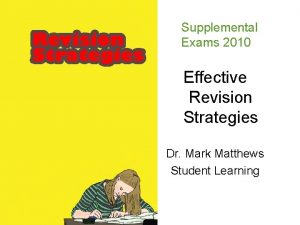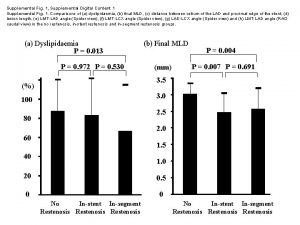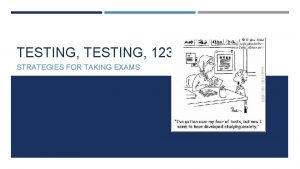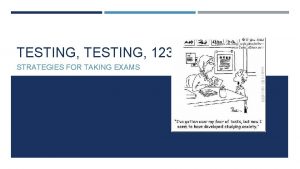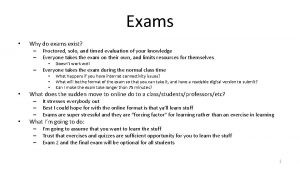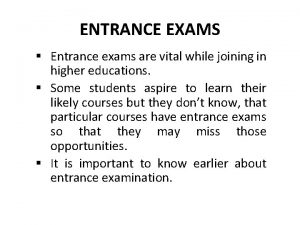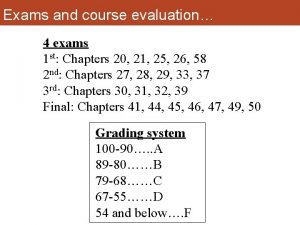Supplemental Exams 2010 Exam Taking Strategies Dr Mark
































- Slides: 32

Supplemental Exams 2010 Exam Taking Strategies Dr. Mark Matthews Student Learning

Doing Well in Exams 1. 2. 3. 4. Grading Reasons for losing marks Practice On the Day Sources: Exam Stress Guide, SU & Student Learning How to Do Badly in Examinations, Dr. Frank Bannister

Grading

Grading I Thorough, deep understanding Critical thinking, insight, creativity Well written Nearly all points II. I Good grasp of subject Critical & Analytical thinking Logical Clear Presentation Nearly all key points

Grading II. II Solid Answer Knowledge beyond lectures Good on facts Writing good, some structure III Knowledge Facts, but little insight Narrow/ No critical thought Poorly written / incoherent F Little Factual Content & Errors

Why you lose marks

Time Wasting • Writing out the question • Writing out multiple choice • Pointless Definitions

Unnecessary content • Taking a long time to get to the point • Irrelevance • Repetition • Present what you know • Add Value • Get to the point

Overcomplication What is meant by each of the following data mining terms? In each case, include a simple example to illustrate your answer. • Decision trees; • Clustering; • Accuracy; • Coverage. (8 Marks)

Overcomplication Decision trees are used in data mining as a way of progressively breaking down data into groups. As this happens, the number in each classification may be noted. A customer database may break down as 70% male, 30% female. The males may be divided into those that spend over € 1, 000 a year with us (90%) and those that do not (10%). The same subdivision for female shows that only 2% of females spend over € 1, 000 with us. The high spending males break-down into 77% under 30 and 23% over 30 years of age. When females are divided into high and low spending, it might be found that 80% of high spenders are repeat customers and 20% are not. Low spending females, on the other hand, might be 90% non repeating customers. A parallel analysis of high spending male customers might show that…

Unbalance Answers Maximum gains for time are in the early stages of your answer Plan your time in advance Rehearse producing quality work in time available Equal Time for Equal Marks

Not Answering the Question • Demonstrating that you understand the question is the first step in producing an answer • How you structure your answer is as important as what you know • More is not necessarily better

Keep Focussed If an idea for a future question “pops into your head”, make some very brief notes so that you don’t loose it and go straight back to the answer you are working on If you have completed an answer and something relevant that you have left out “pops into your head”, go back and add the information as dot points at the end of your answer. Do not try to fit it in over your original script – time and legibility

How you lose marks Re-interpreting the Question Not Answering Multiple Choice Questions Poor English Padding Bullet Points

Padding Work breakdown structures are important. They are used in all projects including civil, mechanical and electrical engineering projects as well as software projects. Work breakdown structures decompose the work to be done in a project into successively smaller components. The result is a hierarchical structure. This is usually done by the project manager, but may be done by sub managers or engineers. Being able to prepare a work breakdown is an important project management skill and needs experience. Specialist engineers may be required to complete a WBS where specialised work is involved. The work breakdown structure enables the project manager to estimate more accurately and later on helps in controlling the project. A typical breakdown may start with a project being divided into phases, stages, activities and tasks. The lowest level in the breakdown is usually a task though occasionally task may be further subdivided into sub-task or even steps. The number of tasks in a project can be very large. The absence of a work breakdown structure can cause problems in a project as it may not be possible to estimate accurately or assign work effectively. If the work breakdown structure is not complete in some way, then the project is almost certain to overrun. One project manager was quoted as saying that a good work breakdown structure is of ‘monumental importance’. A proper work breakdown structure is normally coded with a simple numeric coding system. The work breakdown structure may also be reflected in a Gantt chart. A Gantt chart is a sort of horizontal bar chart used for showing the timing and duration of the various stages of a project.

Think about your examiner


Answer the Question • • Use subject-specific headings Stick to your plan Know how much you can write in the time Say why the issues raised by the question are important

Structure your answer • • • Outline Headings Clear Writing Clear Language Practice

Practice

No practice leads to. . • • • Poor Handwriting Brain Dumping Irrelevance Poor Structure Running out of time Anxiety

Conditional Reflex Develop Your Technique Deconstruct the question: • Restate the question in your own words • Find and use the key words • Show that you know what the point of the question is b defining the key words/concepts/theories/etc • Say how you are going to answer the question

Exam Centres Dozens of exam centres Find out where your exam is. Visit the exam venue

On the Day

Fill out your answer books Don’t hang around outside Don’t discuss the paper after

Which question first? • • • Select the questions you want to answer Do best question first Build up your momentum Do the question you know least well last Leave time to check your work and add dot points

Planning your answer • • Deconstruct the question first Do quick outline Rough notes under headings Then begin to write your answer

Performance on the day • Turn up - make the examiners decide if you know enough to pass • Avoid common mistakes • Structure and content • Go for maximum gains • Manage performance anxiety

Upcoming Workshops Managing Exam Nerves Thursday, August 26 th, 1 - 2 pm Room 3126, Arts Building

Exam Revision Workshop


Student Learning Development Thank you for your time Visit our website at: http: //student-learning. tcd. ie
 Staar released tests
Staar released tests Eog strategies
Eog strategies Test taking strategies for middle school
Test taking strategies for middle school Taking the toeic skills and strategies 1
Taking the toeic skills and strategies 1 Test taking strategies for nursing students
Test taking strategies for nursing students Summarizing and note taking strategies
Summarizing and note taking strategies Summarizing and note taking strategies
Summarizing and note taking strategies Math multiple choice test taking strategies
Math multiple choice test taking strategies Sol test taking strategies
Sol test taking strategies Prayers before examination
Prayers before examination Prayer before taking entrance exam
Prayer before taking entrance exam Coping strategies for exam stress
Coping strategies for exam stress Supplemental table 1
Supplemental table 1 Oracle check supplemental logging enabled
Oracle check supplemental logging enabled Tea blank graphic organizers
Tea blank graphic organizers Tea approved graphic organizers
Tea approved graphic organizers Staar blank graphic organizers
Staar blank graphic organizers Supplemental online coursework
Supplemental online coursework Mcas accommodations manual 2020
Mcas accommodations manual 2020 Supplemental security income (ssi)
Supplemental security income (ssi) Ucla school of nursing supplemental application
Ucla school of nursing supplemental application Ubc nursing program
Ubc nursing program Supplementary figures
Supplementary figures Supplemental table
Supplemental table Supplemental table 1
Supplemental table 1 Galliform with supplemental molt
Galliform with supplemental molt Supplementary figures
Supplementary figures Supplemental instruction
Supplemental instruction Supplemental instruction
Supplemental instruction Iowa state vet school supplemental application
Iowa state vet school supplemental application Supplemental instruction
Supplemental instruction What is supplemental security income
What is supplemental security income Supplemental figure
Supplemental figure



